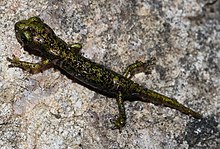Imperial cave salamander
| Imperial cave salamander | |
|---|---|

| |
| Scientific classification | |
| Domain: | Eukaryota |
| Kingdom: | Animalia |
| Phylum: | Chordata |
| Class: | Amphibia |
| Order: | Urodela |
| Family: | Plethodontidae |
| Subfamily: | Plethodontinae |
| Genus: | Speleomantes |
| Species: | S. imperialis
|
| Binomial name | |
| Speleomantes imperialis (Stefani, 1969)
| |

| |
| Dark green: areas of habitation | |
| Synonyms[2] | |
| |
The imperial cave salamander, imperial salamander, odorous cave salamander, or scented cave salamander (Speleomantes imperialis) is a species of salamander in the family Plethodontidae. It is endemic to Sardinia.[1][2]
Habitat and conservation
[edit]Speleomantes imperialis inhabits humid rocky outcrops, caves, crevices, and forested areas near streams at elevations of 7–1,170 m (23–3,839 ft) above sea level. It lays a few terrestrial eggs that have direct development[1] (i.e., there is no free-living larval stage[3]). While common within its limited range and not facing major threats, it can suffer localized habitat loss and illegal collection. It occurs in the National Park of the Gulf of Orosei and Gennargentu and the Monte Sette Fratelli Regional Park, probably also the Giara di Gesturi Regional Park.[1]
References
[edit]- ^ a b c d Franco Andreone; Roberta Lecis; Paul Edgar; Claudia Corti; Roberto Sindaco; Antonio Romano (2009). "Speleomantes imperialis". IUCN Red List of Threatened Species. 2009: e.T20457A9201413. doi:10.2305/IUCN.UK.2009.RLTS.T20457A9201413.en. Retrieved 14 November 2021.
- ^ a b Frost, Darrel R. (2022). "Speleomantes imperialis (Stefani, 1969)". Amphibian Species of the World: An Online Reference. Version 6.1. American Museum of Natural History. doi:10.5531/db.vz.0001. Retrieved 23 March 2022.
- ^ Vitt, Laurie J. & Caldwell, Janalee P. (2014). Herpetology: An Introductory Biology of Amphibians and Reptiles (4th ed.). Academic Press. p. 166.

